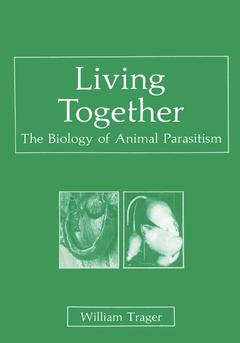Description
Living Together, Softcover reprint of the original 1st ed. 1986
The Biology of Animal Parasitism
Author: Trager W.
Language: English
Subjects for Living Together:
Keywords
Malaria; Pathogene; Protozoa; antigen; biology; ecology; genetics; infection; invertebrates; metabolism; nutrition; parasite; parasites; parasitology; virus; infectious diseases
Publication date: 02-2012
480 p. · 17x24.4 cm · Paperback
480 p. · 17x24.4 cm · Paperback
Description
/li>Contents
/li>
William Trager has been an avid student of parasites for over 50 years at the Rockefeller University. Around the turn of this century, parasitology enjoyed a certain vogue, inspired by colonial responsibilities of the technically ad vanced countries, and by the exciting etiological and therapeutic discoveries of Ross, Manson, Ehrlich, and others. For some decades, the Western hemi sphere's interest in animal parasites has been eclipsed by concern for bacteria and viruses as agents of transmissible disease. Only very recently, initiatives like the Tropical Disease Research programs of WHO-World Bank-UNDP, and the Great Neglected Disease networks of the Rockefeller and MacArthur Foundations have begun to compensate for the neglect of these problems by United States federal health research agencies. Throughout that period, how ever, the Rockefeller Institute (later University) has given high priority to the challenges of parasitism, corresponding during a formidable period with Dr. Trager's own career. The present work then, is a distillation of the insight collected by our principal doyen of parasite biology, informed but by no means confined to his own research. It is addressed to the reader of broad biological interest and training, not to the specialist. The disarmingly unpretentious style makes the work readily accessible to college undergraduates or even to gifted high school students; but do not be deceived thereby, as it has an enormous range of factual information and theoretical insight, familiar to few, but potentially important to most biologists.
1. Introduction.- 2. The Establishment of Infection.- 3. Site Selection within the Host: Entry into Specific Organs and Cells.- 4. The Host-Parasite Interface I: In Extracellular Parasites.- 5. The Host-Parasite Interface II: In Intracellular Parasites (Protozoa and the Nematode Trichinella spiralis).- 6. The Uptake of Nutrients. Digestion.- 7. Nutritional Requirements.- 8. Cultivation of Parasites in Vitro with Special Reference to Differentiation in the Life Cycle.- 9. Metabolism: Energy Sources. Respiration.- 10. Genetics. Developmental Biology.- 11. The Kinetoplast and Kinetoplast DNA.- 12. Parasite-Induced Modifications of the Host: Growth Factors. Effects on Behavior. Parasitic Castration.- 13. Modification of Host Cells Produced by Intracellular Protozoa.- 14. Innate Resistance.- 15. The Spleen.- 16. Immunity in Invertebrates.- 17. The Immune System of Vertebrates in Relation to Parasitic Infections.- 18. Immune Reactions to Trypanosomes and How They Are Evaded. Ablastin. Antigenic Variation.- 19. Immunity to Malaria and Related Intracellular Protozoa.- 20. Immunology of Leishmaniasis and American Trypanosomiasis (Chagas’ Disease).- 21. Schistosomiasis and Concomitant Immunity.- 22. Entamoeba histolytica and Other Intestinal Protozoa. Pathogenesis and Immunology.- 23. Acquired Immunity to Intestinal Nematodes and to Ticks.- 24. Symbiosis.- 25. Chemotherapy.- 26. Ecology and Population Biology of Parasites. Sanitation and Vector Control.- Epilogue.- Taxonomic Index to the Parasites and Vectors Considered.
© 2024 LAVOISIER S.A.S.




